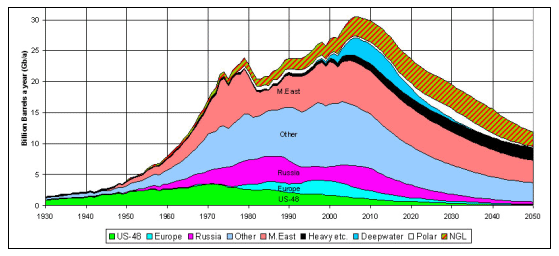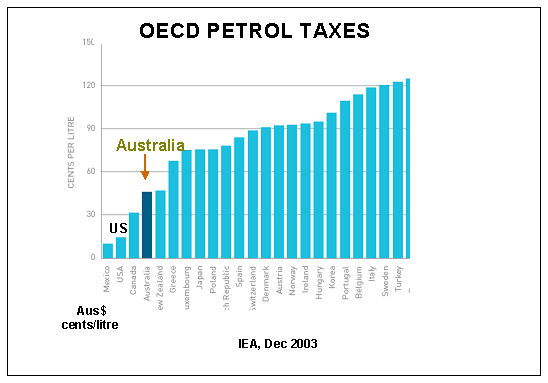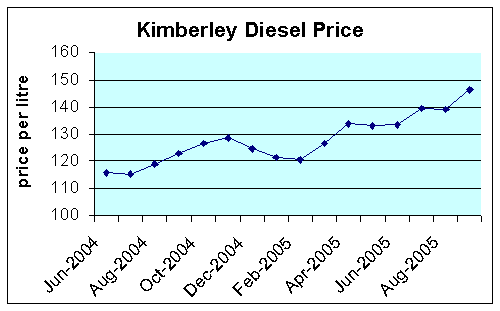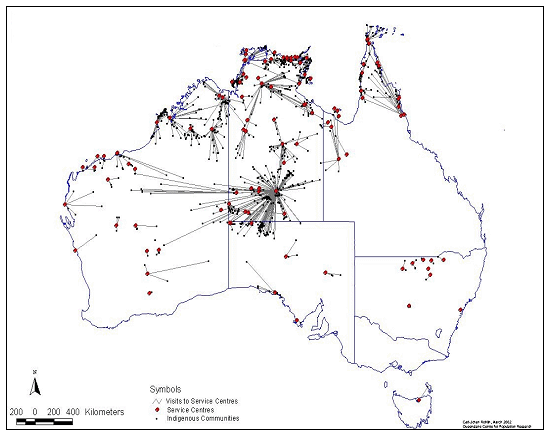Since its Beyond Oil conference in 2003, the Sustainable Transport Coalition (STC) in WA has researched the issue of global oil production and the various arguments for and against peak oil. The Our Oil: Living With Less conference last year featured Dr Ali Samsam Bhaktiari, from Iran, whose predictions of a peak in 2006-07 gained nationwide media attention. Later this month the president of the Association for the Study of Peak Oil & Gas (APSO) in Sweden, Professor Kjell Aleklett, will be hosted by the STC and while in Perth he will announce the establishment of the Australian affiliate of ASPO.
Australians are now more aware of the debate about “Hubbert’s Peak”, the “big rollover” or “peak oil”, as exemplified from this ASPO prediction of a peak in 2008-10. In this essay I won’t discuss arguments for or against the general theory but will highlight the plight of people living in non-urban regions of Western Australia who are already feeling the impact of peaking oil.

Advertisement
What do we know?
Australians, especially urban motorists, are aware that global oil prices have rapidly increased from US$40 per barrel to over US$65 in the past 12 months. There are a growing number of authoritative forecasts such as from the ASPO that global oil production will begin to decline within the next one to five years. Others such as the International Energy Agency are more optimistic, suggesting Peak Oil will be in 2015 or beyond.
There is debate about actual production levels, annual consumption figures and the levels of remaining reserves (especially those of Saudi Arabia). What we do know is that production is already declining in many existing oil fields (for example, production from the UK section of the North Sea declined by 15 per cent last year) and new discoveries have failed to keep pace with annual production since 1980.
Most Australians are now aware that Australia has to import a significant proportion of our annual crude oil needs and that this costs about $12 billion. Motorists in city areas have been surprised by how quickly petrol prices have soared past $1 a litre to over $1.30 a litre and peak motoring organisations have called for the government to lower excise levels as a short-term fix. Data in the IEA figure below shows that Australia has one of the lowest levels of fuel excise in OECD. The position of motorists in Australia is nowhere as dire as those in countries where petrol has been subsidised. The STC web site carries recent stories from countries such as the Philippines, Indonesia, Nigeria and Iran where high oil costs have led to a fall petrol consumption, i.e. “demand destruction” as predicted by classical economic theory.

Who is hurting the most?
The high price of oil is already hurting sectors in the WA economy but has received little media attention; for example, transport firms, agriculture, Indigenous communities and regional tourism. Many small remote Indigenous communities in WA use diesel fuel for power supply as well as transport. In the Western Desert communities, an annual grant for diesel purchase from the Federal Government was based on $1.10 per litre, and they ran out of money in July. A shared responsibility agreement (SRA) has been signed to give the communities additional funds but comes with a whole range of strings attached.
There is already anecdotal evidence that many Aboriginals from smaller communities have begun to leave their land and move into larger settlements, such as South Hedland, to try to ease the burden posed by diesel prices that have risen by 27 per cent in the past 15 months. The graph below from FuelWatch charts the rise in diesel prices in the Kimberley. Many smaller roadhouses have sold it for over $1.80 per litre.
Advertisement

What many Australians don’t understand is how mobile many of the Aboriginal communities are. Those who still lead a traditional life need to travel great distances for customary activities or to interact with government departments. The figure below is from the Centre for Aboriginal Economic Policy Research at ANU.

National figures for owner-drivers of transport vehicles indicate that more than 6,000 have left the industry in the past 12 months due to the high diesel prices. Many of these drivers would have lived in WA as the freight rail network there is only useful in the south-west corner of the state between Geraldton and Esperance.
Other sectors to have suffered include regional tourism with avgas (aviation gas) and avtur fuels costing more than US$100 a barrel. Regional fishing industries have also suffered as they are large consumers of diesel and many of their products are shipped overnight to South-East Asian markets by airfreight (see here for an article on similar pressures being felt in Africa). The rock lobster industry exports over $400 million in produce each year and has been particularly hard hit.
The recent Small Town Survival conference in York, WA, heard how higher petrol prices are driving people from small wheatbelt towns into Perth. This population trend has been evident for some time but higher oil prices have exacerbated it.
Inputs to the agricultural sector have risen by 30 per cent in the past year because many of them (such as fertiliser and herbicides) are based on oil. Those towns trying to combat this trend are basing their future survival on tourism, which itself is already being impacted by oil priced at the current $60-65 per barrel. For example, the local media has reported tourists as having deferred visits to the magnificent wildflower regions this spring. Rural towns such as Moora and Morowa rely on this annual event for valuable income.
Conclusion
The Australian way-of-life based on large populations living in low-density suburbs with a dependence on the car for transport will be shaken if world crude prices rise further to the level of US$190 per barrel predicted by Texan oil banker Matt Simmons.
But Australians living outside our major cities are hurting seriously now. In April 2004 the prime minister raised a copy of the STC’s Oil: Living with Less policy paper in Parliament and ridiculed it as an ALP plot to raise the price of petrol paid by Australian motorists. If he, and the other political leaders to whom we sent the policy, had actually listened to our sensible proposals (such as altering the FBT tax regime) at the time, Australians in both urban and regional areas would now be hurting far less and would be better prepared for even higher oil prices in the future.
Discuss in our Forums
See what other readers are saying about this article!
Click here to read & post comments.
2 posts so far.